|
Size: 667
Comment:
|
Size: 4784
Comment:
|
| Deletions are marked like this. | Additions are marked like this. |
| Line 2: | Line 2: |
| == Subject Coordinate System (SCS) == Definition |
== Subject Coordinate System (SCS / CTF) == Brainstorm uses the CTF coordinate sytem. All the surfaces, sensors and additional points are converted into this system when they are imported in Brainstorm. |
| Line 5: | Line 5: |
| How to position the points | It is defined in the following way: * __Based on__: Nasion, left pre-auricular point (LPA), and right pre-auricular point (RPA). * __Origin__: Midway on the line joining LPA and RPA * __Axis X__: From the origin towards the Nasion (exactly throught) * __Axis Y__: From the origin towards LPA in the plane defined by (NAS,LPA,RPA), and orthogonal to X axis * __Axiz Z__: From the origin towards the top of the head |
| Line 8: | Line 14: |
| === Left pre-auricular point (LPA) === === Right pre-auricular point (RPA) === |
The nasion is the intersection of the frontal and two nasal bones of the human skull. Its manifestation on the visible surface of the face is a distinctly depressed area directly between the eyes, just superior to the bridge of the nose (source: [[http://en.wikipedia.org/wiki/Nasion|Wikipedia]]). Use the coronal orientation to define it. {{attachment:NAS.gif}} === Pre-auricular points (LPA, RPA) === The proper definition of the preauricular point is: "a point of the posterior root of the zygomatic arch lying immediately in front of the upper end of the tragus". The problem with this definition is that it can be really difficult to localize precisely on the MRI. It can lead to severe misregistration between MRI and MEG/EEG. Our proposition is to use instead the junction between the tragus and the helix, marked with a red dot in the following figure. It can be located much more precisely both anatomically and on the MRI slices. {{attachment:preauricular.gif}} Use the sagittal orientation to define it. {{attachment:LPA.gif}} You can choose to use this definition of the "preauricular point" or not. The most important is to use the same convention for all the steps: digitization of head points with a magnetic system (Isotrak Polhemus, ...), and analysis with Brainstorm.<<BR>><<BR>> |
| Line 11: | Line 34: |
| Definition | The atlas that Jean Talairach established for the human brain is base on two points, the posterior and anterior commissure, and the midsagittal plane. The third point needed here, the interhemispheric point, is used to define this plane. To learn more about the Talairach coordinate system, please visit [[http://en.wikipedia.org/wiki/Jean_Talairach|this Wikipedia page]]. |
| Line 13: | Line 36: |
| How to position the points === Anterior comissure (AC) === |
=== Anterior commissure (AC) === |
| Line 18: | Line 39: |
| Technique to localize it: use | Technique to localize it: * Use the axial orientation. * Start from a slice just below the corpus callosum and move around it (slightly up or down) * You are looking for a small fiber tract that connects the two hemispheres * You should find two spots corresponding to this description. The more frontal one is the anterior commissure, the other one is the posterior commissure * Once you have localized it: if it is visible on more than one slice, use the upper one (the one closest to the top of the head). Talairach coordinates: (0, 0, 0). {{attachment:AC.gif}} |
| Line 21: | Line 52: |
| Description of the posterioe commissure at [[http://en.wikipedia.org/wiki/Posterior_commissure|this Wikipedia page]]. | Description of the posterior commissure at [[http://en.wikipedia.org/wiki/Posterior_commissure|this Wikipedia page]]. Technique to localize it: * Use the axial orientation * It is a fiber tract similar to the anterior commissure, but a few centimeters more posterior. * If it is visible on more than one slice, pick the lowest one. Talaraich coordinates: (0, -23, 0) {{attachment:PC.gif}} |
| Line 24: | Line 65: |
| Pick any point in the interhemispheric space, somewhere in the top of the head. Do not use a point too close from the commissures. {{attachment:IH.gif}} <<BR>><<BR>> == Neuromag coordinates system == This coordinates system is not used in Brainstorm, and described here only FYI. All the information contained in Neuromag .FIF files are in this CS, and converted to Brainstorm SCS at importation. It is defined in the following way: * __Based on__: Nasion, left pre-auricular point (LPA), and right pre-auricular point (RPA). * __Origin__: Intersection of the line L throught LPA and RPA and a plane orthogonal to L and passing throught the nasion. * __Axis X__: From the origin towards the RPA point (exactly throught) * __Axis Y__: From the origin towards the nasion (exactly throught) * __Axiz Z__: From the origin towards the top of the head == Converting between coordinate systems == ==== MRI (milimeters) to SCS (meters) ==== You need the a structure sMri that contains the information about the fiducials (nasion, left ear, right ear), and/or the transformation: [CODE]sMri.SCS.NAS = [x, y, z]; [/CODE] |
Coordinate systems
Subject Coordinate System (SCS / CTF)
Brainstorm uses the CTF coordinate sytem. All the surfaces, sensors and additional points are converted into this system when they are imported in Brainstorm.
It is defined in the following way:
Based on: Nasion, left pre-auricular point (LPA), and right pre-auricular point (RPA).
Origin: Midway on the line joining LPA and RPA
Axis X: From the origin towards the Nasion (exactly throught)
Axis Y: From the origin towards LPA in the plane defined by (NAS,LPA,RPA), and orthogonal to X axis
Axiz Z: From the origin towards the top of the head
Nasion (NAS)
The nasion is the intersection of the frontal and two nasal bones of the human skull. Its manifestation on the visible surface of the face is a distinctly depressed area directly between the eyes, just superior to the bridge of the nose (source: Wikipedia).
Use the coronal orientation to define it.
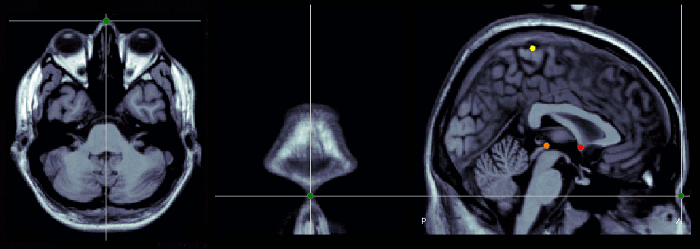
Pre-auricular points (LPA, RPA)
The proper definition of the preauricular point is: "a point of the posterior root of the zygomatic arch lying immediately in front of the upper end of the tragus". The problem with this definition is that it can be really difficult to localize precisely on the MRI. It can lead to severe misregistration between MRI and MEG/EEG.
Our proposition is to use instead the junction between the tragus and the helix, marked with a red dot in the following figure. It can be located much more precisely both anatomically and on the MRI slices.
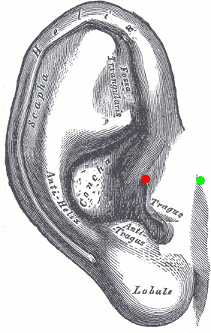
Use the sagittal orientation to define it.
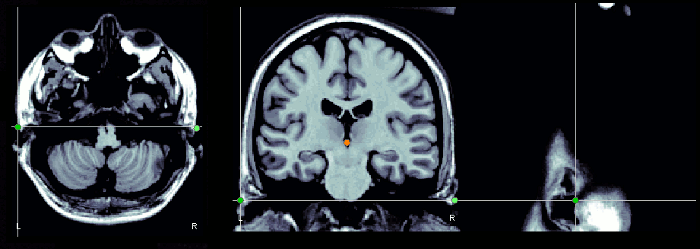
You can choose to use this definition of the "preauricular point" or not. The most important is to use the same convention for all the steps: digitization of head points with a magnetic system (Isotrak Polhemus, ...), and analysis with Brainstorm.
Talaraich coordinate system
The atlas that Jean Talairach established for the human brain is base on two points, the posterior and anterior commissure, and the midsagittal plane. The third point needed here, the interhemispheric point, is used to define this plane. To learn more about the Talairach coordinate system, please visit this Wikipedia page.
Anterior commissure (AC)
Description of the anterior commissure at this Wikipedia page.
Technique to localize it:
- Use the axial orientation.
- Start from a slice just below the corpus callosum and move around it (slightly up or down)
- You are looking for a small fiber tract that connects the two hemispheres
- You should find two spots corresponding to this description. The more frontal one is the anterior commissure, the other one is the posterior commissure
- Once you have localized it: if it is visible on more than one slice, use the upper one (the one closest to the top of the head).
Talairach coordinates: (0, 0, 0).
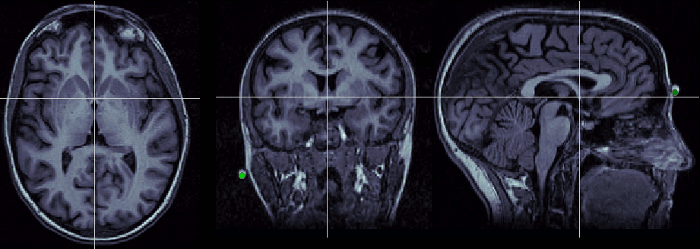
Posterior commissure (PC)
Description of the posterior commissure at this Wikipedia page.
Technique to localize it:
- Use the axial orientation
- It is a fiber tract similar to the anterior commissure, but a few centimeters more posterior.
- If it is visible on more than one slice, pick the lowest one.
Talaraich coordinates: (0, -23, 0)
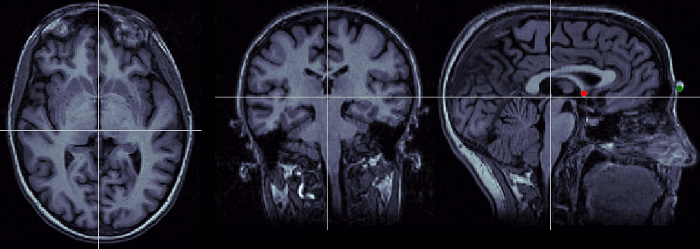
Interhemispheric point (IH)
Pick any point in the interhemispheric space, somewhere in the top of the head. Do not use a point too close from the commissures.
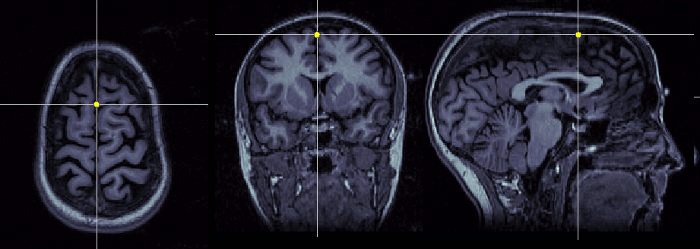
Neuromag coordinates system
This coordinates system is not used in Brainstorm, and described here only FYI. All the information contained in Neuromag .FIF files are in this CS, and converted to Brainstorm SCS at importation.
It is defined in the following way:
Based on: Nasion, left pre-auricular point (LPA), and right pre-auricular point (RPA).
Origin: Intersection of the line L throught LPA and RPA and a plane orthogonal to L and passing throught the nasion.
Axis X: From the origin towards the RPA point (exactly throught)
Axis Y: From the origin towards the nasion (exactly throught)
Axiz Z: From the origin towards the top of the head
Converting between coordinate systems
MRI (milimeters) to SCS (meters)
You need the a structure sMri that contains the information about the fiducials (nasion, left ear, right ear), and/or the transformation:
[CODE]sMri.SCS.NAS = [x, y, z];
[/CODE]
